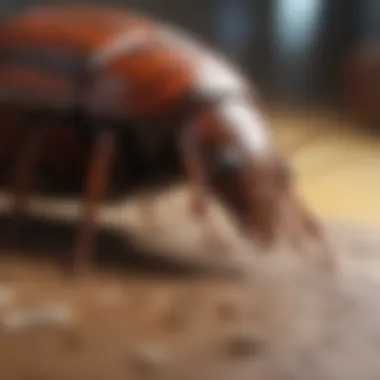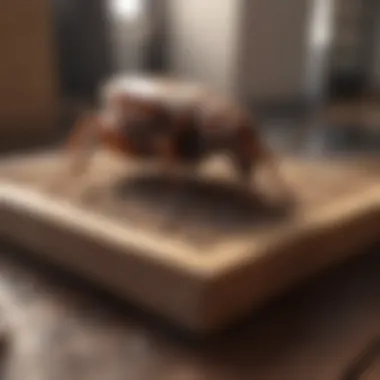Effective Homemade Remedies to Eliminate Cockroaches


Intro
Cockroaches are among the most notorious pests in households worldwide. Their presence triggers disgust and anxiety in many people. This article seeks to present a range of homemade remedies that can effectively combat cockroach infestations. With the increasing concern over the health risks associated with harsh chemicals, exploring safe and eco-friendly solutions is quite necessary.
Throughout this guide, we will examine the ingredients commonly used in these remedies, their methodologies, and the underlying scientific principles that contribute to their effectiveness. A deeper understanding of these aspects can empower readers to choose appropriate measures to regain control of their living spaces.
Animal Profile
General Overview
Cockroaches belong to the order Blattodea. They are characterized by their flat, oval bodies and long antennae. There are several species of cockroaches, with the American cockroach and the German cockroach being the most common in urban areas. These insects are primarily nocturnal and adept at evading detection.
Habitat and Distribution
Cockroaches are highly adaptable creatures. They thrive in a variety of environments, from warm and damp areas to dark and secluded spaces within human structures. Their distribution is global; they inhabit regions across all continents except Antarctica. This adaptability makes them a persistent challenge in pest control.
Effective Homemade Remedies
To effectively deal with cockroaches, several homemade remedies can be employed. Below are some of the most notable ones:
- Boric Acid: This compound disrupts the cockroach’s digestive system. Mixing it with sugar can attract them.
- Baking Soda and Sugar: A mixture of these two can also be effective. Cockroaches consume the mixture, which leads to their demise.
- Soap and Water Spray: A mixture of liquid soap and water can suffocate cockroaches upon contact.
- Essential Oils: Oils such as peppermint or tea tree can repel cockroaches due to their strong scents.
Application Methods
Effectiveness is contingent upon the correct application of these homemade remedies. Here are suggested methods:
- Boric Acid: Place small amounts in areas where cockroaches frequent. Ensure it is out of reach of pets and children.
- Baking Soda and Sugar: Mix equal parts and place the solution in shallow containers near cockroach hotspots.
- Soap and Water Spray: Fill a spray bottle and apply directly to visible cockroaches to suffocate them.
- Essential Oils: Diffuse or spray diluted essential oils around your home to deter cockroaches from entering.
Culmination
Managing cockroach infestations can be achieved through various homemade remedies. Understanding these methods and their scientific basis plays a crucial role in effective pest control. By employing safe and eco-friendly solutions, individuals can reclaim their living spaces without reliance on harsh chemicals.
Preamble to Cockroach Infestations
Cockroaches are notorious pests that pose various challenges in households and businesses alike. Understanding their behaviors and the factors contributing to infestations is essential for effective management. Cockroaches are highly adaptable creatures, thriving in diverse environments. Their presence is often a sign of poor hygiene or conditions that favor their survival. Investigating these aspects allows individuals to take proactive measures against infestations.
Understanding Cockroaches
Cockroaches belong to the order Blattodea, with over 4,500 species identified worldwide. However, only a few species are common household pests. The American cockroach, German cockroach, and Oriental cockroach are some of the most prevalent. They prefer dark, damp areas such as kitchens, basements, and bathrooms.
Understanding the life cycle of cockroaches, from egg to adult, is crucial. Female cockroaches can produce up to 400 offspring in their lifetime, making swift elimination essential. Cockroaches are nocturnal and tend to avoid light, which aids their survival in human environments.
The Impact of Cockroaches on Health
Cockroaches are not just a nuisance but also a potential health risk. They are known carriers of various pathogens, bacteria, and allergens. The presence of cockroaches may contribute to respiratory issues, especially in sensitive individuals. Their droppings, saliva, and body parts may trigger allergic reactions. Moreover, cockroaches have been linked to diseases such as Salmonella and gastroenteritis, making their control a priority for maintaining health standards within living spaces.
Why Choose Homemade Remedies?
Opting for homemade remedies when dealing with cockroach infestations presents multiple advantages. First, these solutions are often more eco-friendly compared to commercial pesticides, reducing chemical exposure in the household. Many homemade ingredients are readily available in most kitchens, such as baking soda, boric acid, and soap. This accessibility allows for immediate action against infestations without the need for professional pest control services. Moreover, homemade remedies can provide an economical alternative, making pest control more manageable for many households.


In summary, addressing cockroach infestations requires not only an understanding of the pests themselves but also a recognition of the health risks they pose. The shift towards homemade remedies is increasingly popular, offering effective, safe, and economical solutions. As we proceed through this article, we will explore specific homemade ingredients and methods to tackle cockroach problems effectively.
Common Ingredients for Homemade Cockroach Remedies
In the quest to eliminate cockroach infestations, choosing effective components is crucial. Homemade remedies offer a natural alternative to chemical solutions. They leverage readily available ingredients known for their pest control properties. Recognizing these common ingredients helps individuals make informed decisions on how to tackle their pest problems.
Boric Acid
Properties and Efficacy
Boric acid is a well-known substance in pest control circles. Its effectiveness comes from its ability to disrupt the cockroach's digestive system. Once ingested, boric acid can lead to dehydration and eventually death. This makes it a popular choice for those seeking a method that does not involve harsh chemicals. A key advantage is its low toxicity to humans and pets when used correctly. However, improper application can lead to ineffectiveness, as cockroaches may avoid the treated area if they sense danger.
Application Methods
Using boric acid effectively requires careful application. It's often used in powder form sprinkled in areas where cockroaches are likely to gather, such as behind appliances or under sinks. To maximize efficacy, a thin layer is crucial; too much can deter cockroaches due to its repellent nature. Another method involves mixing boric acid with sugar or water, creating bait that attracts and kills these pests. While boric acid is potent, it must be kept away from children and pets to prevent accidental ingestion.
Diatomaceous Earth
Mechanism of Action
Diatomaceous earth functions differently than most chemical treatments. It consists of tiny fossilized algae that are abrasive to insects. When cockroaches come into contact with it, the powder damages their exoskeleton, leading to dehydration. This method's popularity stems from its natural origin and effectiveness. It poses a minimal risk to humans, making it a suitable choice for eco-conscious individuals.
Usage Guidelines
For effective use, diatomaceous earth should be applied in dry conditions. It can be spread in thin layers around entry points and nesting areas. Regular replenishment is necessary, particularly after cleaning or if it gets moist, as water reduces its efficacy. While it provides a long-lasting solution, its effectiveness may take time. Therefore, patience is essential when utilizing this method for pest control.
Soap and Water Solutions
How It Operates
Soap solutions serve as an effective way to suffocate cockroaches. The soap acts to break down the surface tension of the water, allowing it to infiltrate their spiracles, or breathing pores, leading to drowning. This method is simple and can be made with household items, making it accessible to everyone. Its key characteristic is that it can be applied during regular cleaning routines, creating a dual-purpose solution that promotes cleanliness and pest control simultaneously.
Effective Ratios
To create an effective solution, a common ratio is one part soap to two parts water. However, the specific type of soap is vital; liquid dish soap tends to be most effective. This ratio allows for sufficient soap concentration to eliminate cockroaches. It's crucial to apply this solution directly onto visible pests or in areas of heavy activity. However, while soap spray is effective against visible cockroaches, it may not address the broader infestation unless combined with other methods.
Baking Soda and Sugar
Chemical Reaction
Baking soda, when ingested by cockroaches, reacts with their digestive fluids to produce carbon dioxide. This reaction can result in the death of the insect. When combined with sugar, it becomes more appealing to cockroaches. This attraction significantly increases the likelihood of consumption. Its appealing nature and efficacy make brownies soda a commonly recommended remedy.
Preparation Steps
Preparing a baking soda bait is straightforward. Typically, a mixture of equal parts baking soda and sugar is created. It can be placed in small containers or DIY bait stations near cockroach hot spots. Regularly check and replace the bait to keep it fresh and attractive to pests. While this method is generally safe, it may not yield immediate results, as the time taken for cockroaches to consume it can vary.
Specific Homemade Remedies
Homemade remedies play a crucial role in tackling cockroach infestations. They provide an accessible and less toxic alternative to commercial pesticides. Understanding these specific remedies allows individuals to manage pest problems safely in homes or workplaces. This section details several effective methods for controlling cockroaches with common household ingredients.
Boric Acid Mixture


Ingredients Required
Boric acid is a preferred ingredient in homemade cockroach remedies due to its unique properties. It acts as a stomach poison to cockroaches. The ideal combination includes boric acid, sugar, and water. The sugar entices cockroaches to consume the mixture, leading to their demise. One key characteristic of boric acid is its low toxicity to humans and pets when used properly. This makes it a safe choice for households concerned about chemical exposure.
Application Tips
To maximize the effectiveness of a boric acid mixture, it is important to follow specific application tips. Place the mixture in small containers in areas frequented by cockroaches, such as behind appliances or under sinks. A little goes a long way, and this method not only attracts but also kills the insects. This method's highlight is its long-lasting effect, as the residue remains potent for days. However, users should avoid applying it in open areas where pets or children are present.
Diatomaceous Earth Spread
How to Apply
Diatomaceous earth is an excellent option for those seeking a dry, mechanical solution. To apply it, sprinkle an even layer in cracks, crevices, and along baseboards. The microscopic sharp edges of the diatomaceous earth physically harm the cockroaches when they come into contact with it. This method is beneficial as it is non-toxic and does not rely on chemical reactions, yet it requires some time before showing noticeable results.
Safety Precautions
Safety precautions are paramount when using diatomaceous earth. It is crucial to ensure that the product is food grade if used in living areas. Although it is safe for humans and pets, inhalation of the fine powder should be avoided. A mask can be helpful during application to prevent inhalation. Highlighting safety creates trust in this approach, especially for households with vulnerable residents.
Soap Spray
Creating the Solution
A soap spray is a simple yet effective method for killing cockroaches on contact. To create this solution, mix water with liquid soap—ideally, castile soap—for effectiveness. The soap works by suffocating the cockroaches, blocking their breathing pores. The simplicity of its creation is a major advantage. Users can customize the solution's strength based on their needs.
Recommended Application Areas
For the best results, applying the soap spray in areas where cockroaches are commonly seen or suspected is recommended. This includes under sinks, behind appliances, and in dark corners. Being persistent and regularly reapplying the spray after it dries is essential for effectiveness. Its non-toxic nature is attractive, making it widely embraced as a remedy.
Baking Soda Bait
How to Prepare
Baking soda is another useful ingredient in homemade cockroach remedies. To prepare it, mix equal parts of baking soda and sugar. The sugar lures the cockroaches, while the baking soda reacts with their stomach acid, causing them to perish. This method stands out due to its low cost and easy accessibility. Many households have these ingredients on hand, making preparation quick and efficient.
Best Practices for Use
Utilizing the baking soda bait effectively requires a few best practices. Place small amounts of the mixture in locations where cockroaches are active. It is critical to monitor and replenish bait as needed. Additionally, keeping the area clean and disposing of any dead insects reduces further infestation risks. One unique feature is that this bait approach brings peace of mind, knowing that it is safe for use in food preparation areas when applied correctly.
Preventive Measures Against Cockroaches
Preventing cockroach infestations is critical for maintaining a healthy living environment. While homemade remedies can effectively eliminate problem once they arise, addressing the root cause helps avoid their return. By understanding specific measures to deter cockroaches, one can minimize the need for reactive solutions.
Maintaining Cleanliness
One of the most effective preventive strategies for keeping cockroaches at bay is maintaining cleanliness in and around the home. Cockroaches thrive in unsanitary conditions and are drawn to food debris, spills, or accumulated waste. Prioritizing cleanliness involves urgent actions like:
- Regularly sweeping, vacuuming, and mopping floors to eliminate crumbs and residues.
- Wiping down surfaces, especially in kitchens and dining areas where food is prepared or consumed.
- Storing food in airtight containers to remove potential food sources for cockroaches.
A clean home not only deters cockroaches but also provides numerous health benefits. Overall, keeping areas tidy limits the comfort zone for these pests, making it less likely they will settle in.
Sealing Entry Points


Cockroaches are small and quite adept at finding their way into homes through tiny cracks and crevices. Sealing these entry points serves as a highly effective preventive measure. Notable actions include:
- Inspecting exterior walls and the foundation of the house for gaps.
- Applying caulk or weather stripping around windows and doors.
- Ensuring that plumbing holes and vent openings are adequately sealed.
By making these adjustments, you create barriers that limit finding a way inside. In addition, careful observation during this process may reveal other potential issues needing attention to maintain overall home security.
Regular Inspections
Regular inspections of your living spaces ensure that any early signs of cockroach activity are addressed promptly. This proactive approach may involve:
- Checking hidden areas such as behind appliances, under sinks, or in storage areas.
- Monitoring areas where food is prepared or stored, looking for droppings or shed skin.
- Keeping an eye on dark, damp places where cockroaches typically hide, like basements or attics.
By performing routine inspections, you can detect threats before they escalate into a full-blown infestation. This vigilance cultivates an overall understanding of your living environment and contributes to sustainable pest management.
Implementing preventive measures against cockroaches embodies a strategic effort that not only reduces their presence but fosters a healthier living space.
Effectiveness of Homemade Remedies
Understanding the effectiveness of homemade remedies is vital for anyone dealing with cockroach infestations. These remedies often provide a safer, more eco-friendly approach compared to traditional chemical pesticides. Effectiveness in this context involves evaluating the success rates of these methods and their overall impact on pest control. The use of non-toxic ingredients minimizes health risks for inhabitants, particularly in households with children or pets. Furthermore, homemade solutions often come with lower costs and simpler application processes, making them appealing for many people.
Scientific Basis
Studies on Efficacy
Research indicates that certain homemade remedies can significantly reduce cockroach populations. For instance, studies have shown that boric acid, a common ingredient in many homemade solutions, targets the digestive system of cockroaches when ingested. This property allows it to act effectively against these insects, leading to high mortality rates.
The key characteristic of these studies is the focus on the pest's biology and behavioral patterns. These insights make homemade remedies relevant choices for pest management.
Unique features of these studies include comparative metrics that often measure the effectiveness of various ingredients against cockroaches. While chemical solutions may offer fast results, homemade remedies demonstrate long-term success with repeat applications. However, one disadvantage could be the variability in results, depending on the specific infestation conditions and the methods applied.
Comparative Analysis with Chemical Solutions
Comparing homemade remedies with chemical solutions reveals significant differences. Homemade options often focus on sustainability and health safety, whereas chemical solutions may address infestations more rapidly but with potential health implications. The rapid effectiveness of chemical solutions can be alluring, yet the potential for chemical exposure raises concerns.
A notable aspect of this analysis is the growing public skepticism regarding the safety of chemical insecticides. This has led to an increased interest in natural alternatives.
When evaluating both approaches, the advantages of homemade remedies often include less aggressive ingredients and an overall lower risk profile. On the flip side, chemical solutions sometimes provide immediate relief, which can be necessary in severe infestations. Striking the right balance between safety and effectiveness remains a critical consideration.
Real User Experiences
User testimonies often verify the effectiveness of homemade remedies. Many individuals have shared success stories using common household ingredients. They report significant reductions in cockroach sightings over time. These experiences provide practical insights that enrich the ongoing conversation about pest control methods. Many users appreciate how these remedies align with their values of safety and eco-friendliness.
Personal feedback often highlights how the application process is straightforward. Users enjoy the affordability of the ingredients they already have at home. However, some mention that patience is key, as results may not be immediate. This narrative paints a balanced view of homemade options, paving the way for informed decision-making in pest management.
Closure
Summary of Key Points
- Effectiveness: Homemade remedies can successfully reduce cockroach populations without relying on harsh chemicals.
- Common Ingredients: Effective ingredients like boric acid, diatomaceous earth, and baking soda have been discussed, highlighting their properties and usage.
- Scientific Basis: The efficacy of these remedies is supported by scientific studies that offer a comparative analysis with traditional chemical solutions.
- User Experiences: Real-world examples showcase high satisfaction from users who have tried these remedies.
- Preventive Measures: Continuing vigilance through cleanliness and sealing entry points can help sustain results from these remedies.
Final Recommendations
It is advisable for readers to consider integrating homemade remedies as part of their pest management strategy. Here are some considerations:
- Safety First: Choose safe ingredients and be cautious with applications around children and pets.
- Consistency: Regularly apply these remedies and maintain a clean environment to prevent re-infestation.
- Document Results: Keep track of the remedies used and measure their effectiveness, as user feedback is invaluable.
- Tailored Approach: Assess the specific characteristics of your infestation before choosing a remedy to ensure the best outcome.
By taking these steps, individuals can reclaim their spaces effectively while prioritizing health and well-being.















